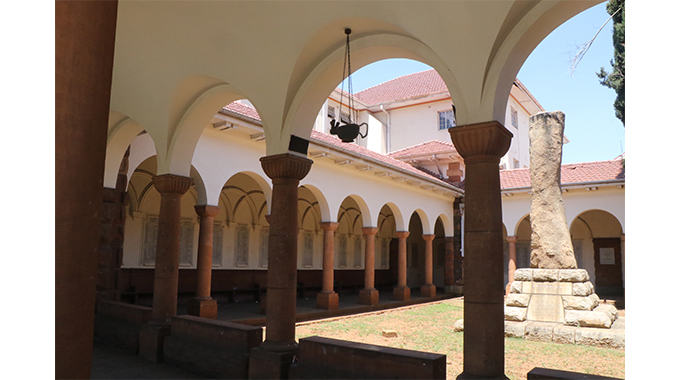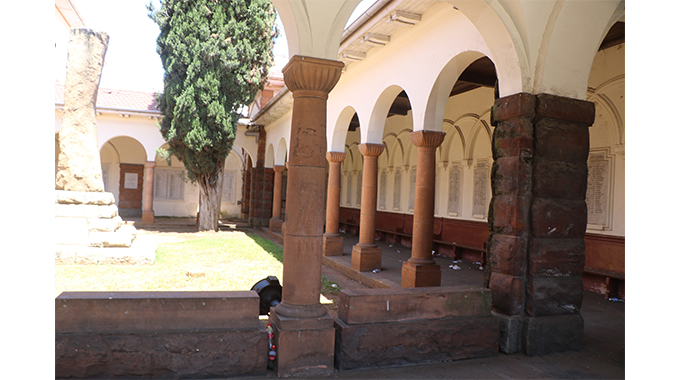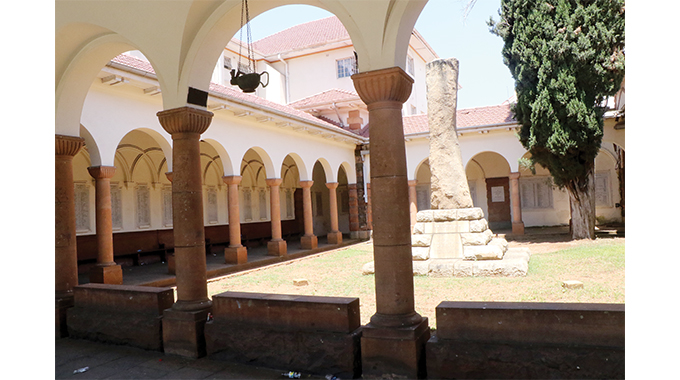
The Sunday News

Bruce Ndlovu, Sunday Life Reporter
A gaping hole now exposes the western part of the Post Office Gardens. It is perhaps ironic that a building also known as the War Memorial Park or the Cenotaph, now looks like it was the victim of a night time air raid from squadrons of enemy forces.
However, in truth, despite how the Post Office Gardens look, Bulawayo is not under siege from any enemy. The only weapon forged against Bulawayo’s beloved Post Office Gardens is time, as its steady passage has meant that in 2022, the roof of one of the most popular rest and leisure spots in the city is finally beginning to crumble. Recently, a video of the crumbling roof began circulating, alerting many to the decay taking place at Joshua Mqabuko Street and 8th Avenue.

Post Office court yard
If the voice behind the video, which sounded plagued with despair and righteous anger in equal measure, was to be believed, the collapse of the roof was a threat to the memory of many people’s childhood and young adulthoods. This is where marriages were made, the voice said, the one place where young people would come to pass time and the lucky few would walk away with those to whom they would eventually utter the words, “Till death do us part.”
However, now those memories are under threat as the gardens seem to be losing their lustre, with the crash of the roof becoming the great symbol of their fall. Established after the uprisings in Matabeleland upon settler invasion, the gardens were known as the Matabeleland War Memorial until after the First World War, when they became known as the Cenotaph.
The cenotaph was unveiled in 1925 by Edward, Prince of Wales, a man who would abdicate his throne 11 years later. A cenotaph is an empty tomb or monument erected in honour of a person or group of people whose remains are elsewhere.

It can also be the initial tomb for a person who has since been reinterred elsewhere. Although the vast majority of cenotaphs honour individuals, many noted cenotaphs are instead dedicated to the memories of groups of individuals, such as the lost soldiers of a country or of an empire.
Located at the centre of the gardens, the natural granite pillar that rises impressively from the ground onto the Bulawayo sky came from a rock hewn from the Matobo Hills. As testament to the toughness of any unyielding rock harvested from the picturesque Matopos, the pillar stands steadfast, seemingly unmolested by the same hand of time that has harassed the roof to its fall.
It is surrounded by a cloister where the names are inscribed of those Rhodesians who died in the First and Second World wars, as well as some of those killed in later campaigns. Like other monuments in Bulawayo, this aspect makes the gardens seem as if they are from a bygone age, as they recognise mostly white troops whose lives were taken in those two conflicts waged on behalf of the British empire.
In past organised tours, guides have indicated, plans are now underway to make it more inclusive, commemorating all who have fallen in the name of Zimbabwe.
This is yet to come to pass. On an ordinary day in Bulawayo, however, one can observe weary travellers or workers taking a rest around the cenotaph, with some using it as they preferred lunch or breakfast spot, munching away on oily chips or sausages under the names of faceless men who died in faraway theatres of war a long time ago.

However, while they might not be familiar with the names on the walls, the gardens themselves hold great sentimental value to a lot of people in Bulawayo, which is perhaps why the sight of the roof’s collapse set off a social media frenzy. Responding to questions from Sunday Life, Bulawayo City Council (BCC) corporate communications manager Nesisa Mpofu said the city fathers were in consultation with other stakeholders on how to restore the gardens to their former glory.
“The City of Bulawayo is the registered owner of the property (Stand 78A Bulawayo Township) including the improvements. The site is listed in terms of Museums and Monuments Act due to its Historical and Architectural Merit. As such Zimbabwe Posts (Pvt) Ltd and National Museums and Monuments had been responsible for its maintenance while the City of Bulawayo was responsible for maintaining the park grounds (Post Office Gardens, also known as Cenotaph or War Memorial Park).

Engagements are currently in progress with the above-mentioned authorities together with the Public Works Department on the renovations of the veranda area that covers the cenotaphs. The City of Bulawayo has taken the lead in so far as the eminent danger is concerned in removing the collapse roof.
The City is liaising and awaiting guidance from the other organisation regarding renovations,” she said.
Mpofu added that renovations on such structures could not be done on a whim, as they were heritage sites that were an integral part of the cityscape. In 2017, the roof of a heritage building housing the city’s only Nando’s outlet collapsed, killing one person and injuring three others.
“All buildings with historical or architectural merit are protected. Whenever such buildings are to be renovated, extended, demolished or any structural work is to be done on the same, clearance must be sought in the first instance from the City of Bulawayo and The National Museums and Monuments. A reference case is the Grand Hotel which was located along Joshua Mqabuko Nyongolo Nkomo Street between 9th Avenue and 10th Avenue, which had to be incorporated into the now Bulawayo Centre.
That was done to preserve the architecture and history of the city.
“. . . Historic buildings are witness to the aesthetic and cultural history of the city, and they give people a sense of place and connection to the past. These represent famous and important things to the people who live in Bulawayo and those visiting. As such these are a form of preserving the history of the city in terms of its origins, the way of life, incidents of note, building materials that are found locally and the pre-colonial and post-colonial architecture. They tell the story of Bulawayo in a visual way. They are also heritage buildings as they are linked to the heritage of the city,” said Mpofu.



